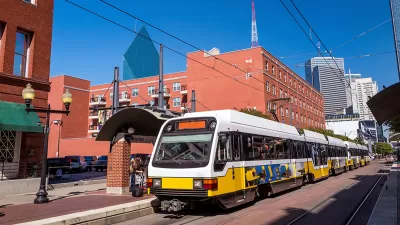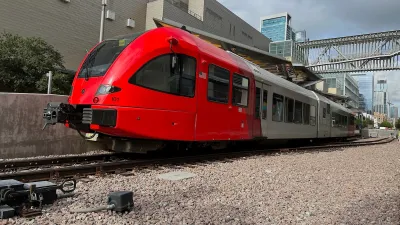Though "generally cited as an example of all the things you don’t want a city to be," Karrie Jacobs finds reason to believe that Texas's third largest city has taken to heart the "country’s newfound passion for all things urban."
Spurred by a plan approved last year called Downtown Dallas 360, and "the bottomless capacity of local philanthropists," the city is embarking on efforts to increase the downtown residential population, expand multi-modal transportation options, and provide pedestrian-friendly streetscapes. Plenty of obstacles to establishing an urban utopia still remain, however, primarily in the form of an elevated asphalt noose encircling the city.
According to Jacobs, planners "offer few strategies for dealing with the constraints posed by the elevated freeways. Apparently, there's no local appetite for removing the highways, even in the interest of an improved urban experience. Indeed, at the same time that the city is talking about surrounding the Trinity River with parkland, it's planning to run a new toll road within the river's levees."
Although the challenges are immense, Jacobs lauds the effort to transform the city.
"While the attempt to make central Dallas walkable is something of a long shot, the desire seems genuine. And the fact that this is happening in a state not known for progressive thinking, and in a city built largely by and for the oil industry, suggests that this country's newfound passion for the communal pleasures of urban life runs deep, representing a generational shift that has the power to transcend political and geographic boundaries."
FULL STORY: Instant Urbanism

Trump Administration Could Effectively End Housing Voucher Program
Federal officials are eyeing major cuts to the Section 8 program that helps millions of low-income households pay rent.

Planetizen Federal Action Tracker
A weekly monitor of how Trump’s orders and actions are impacting planners and planning in America.

Ken Jennings Launches Transit Web Series
The Jeopardy champ wants you to ride public transit.

Washington Legislature Passes Rent Increase Cap
A bill that caps rent increases at 7 percent plus inflation is headed to the governor’s desk.

From Planning to Action: How LA County Is Rethinking Climate Resilience
Chief Sustainability Officer Rita Kampalath outlines the County’s shift from planning to implementation in its climate resilience efforts, emphasizing cross-departmental coordination, updated recovery strategies, and the need for flexible funding.

New Mexico Aging Department Commits to Helping Seniors Age ‘In Place’ and ‘Autonomously’ in New Draft Plan
As New Mexico’s population of seniors continues to grow, the state’s aging department is proposing expanded initiatives to help seniors maintain their autonomy while also supporting family caregivers.
Urban Design for Planners 1: Software Tools
This six-course series explores essential urban design concepts using open source software and equips planners with the tools they need to participate fully in the urban design process.
Planning for Universal Design
Learn the tools for implementing Universal Design in planning regulations.
Heyer Gruel & Associates PA
Ada County Highway District
Institute for Housing and Urban Development Studies (IHS)
City of Grandview
Harvard GSD Executive Education
Toledo-Lucas County Plan Commissions
Salt Lake City
NYU Wagner Graduate School of Public Service





























